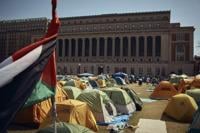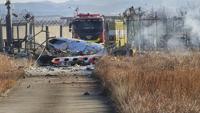WASHINGTON (AP) — On May 28, 2020, Associated Press photographer Julio Cortez got a call asking him to head to Minneapolis from the East Coast. What he saw on the ground was unlike any protest he’d ever covered. It was then that he knew something had shifted in the Black Lives Matter movement.
Cortez is one of three AP staff members featured in this episode of The Story Behind the AP Story, a recurring audio production that features extended interviews with AP journalists discussing their stories and process.
This episode includes two journalists on the scene in Minneapolis, Cortez and AP reporter Steve Karnowski. And AP race and ethnicity editor Aaron Morrison provides analysis of the coverage and looks into the reckoning on race in America.
___
EDITOR’S NOTE — Over the next few weeks, The Associated Press will publish a series of stories exploring the impact, legacy and ripples of what is widely called the “Ferguson uprising” that sparked nationwide outcries over police violence and calls for broader solutions to entrenched racial injustices. The series provides a sprawling look at racial justice in American life, from stories about how the uprising changed the U.S. Department of Justice and how corporations sought to boost their profiles by donating to the movement, to examinations of a reckoning on race in schools, churches, politics, sports and public health.
___
HAYA PANJWANI, host: Ten years ago, the death of a Black teenager named Michael Brown in Ferguson, Missouri, sparked a racial reckoning. Protests broke out in the suburban city, eventually becoming what some deemed as ground zero for the Black Lives Matter movement.
A few years later, in 2020, George Floyd was killed in Minneapolis, bringing further attention to the movement.
I’m Haya Panjwani. On this episode of The Story Behind the AP Story, we’ll be hearing from two reporters.
JULIO CORTEZ, photographer: Julio Cortez, chief photographer for the Texas and Oklahoma region of the Associated Press.
STEVE KARNOWSKI, reporter: I’m Steve Karnowski. I’m a reporter in the Minneapolis bureau of the Associated Press.
PANJWANI: Julio photographed the demonstrations that followed the death of George Floyd in Minneapolis in 2020, while Steve followed the legal proceedings.
KARNOWSKI: That was a very scary time. Minneapolis hasn’t seen that kind of unrest in a generation. Not since the '60s, really, have we had full scale riots here. So, it was very disturbing to see that happening in your own city.
CORTEZ: I had seen on TV what was going on. It looked very involved, very fluid, very dangerous. When I got the call the morning of May 28 to get deployed into Minneapolis, start seeing things for myself. It was much more intense in person than it was on TV.
I was very scared for many reasons, not just because of the violence, but also this is right in the middle of a pandemic. So, I was really afraid of catching something and never coming home.
You know, as a person of color covering these events, I feel things that maybe the community is feeling. I can sympathize, I can understand what’s going on. While I’m trying to do my job as objectively as possible, I am feeling some of that anger, and I don’t let those feelings dictate how I photograph. But I do use those feelings to kind of reflect in the images what’s going on and what, what we’re seeing.
Ninety-nine percent of the protests I’ve ever covered were not violent. I worked for the AP in New Jersey for almost nine years, so I did a lot of New York City, NYPD protests up and down Manhattan. They were aggressive, but I never saw the sort of violence that I saw in Minneapolis.
KARNOWSKI: After George Floyd was killed, and word spread and anger grew — besides peaceful but angry protests, rioting broke out in parts of the Minneapolis-St. Paul area, which is something that we hadn’t seen before.
It resulted in not just windows being broken, but it culminated with the burning of the police station where the officers involved in this had been based.
CORTEZ: People were very angry and showing a lot of emotion. The protests had taken a new meaning in America. It was no longer picket signs and, and people peacefully walking places. It was people taking on a very aggressive approach to voice what they felt.
KARNOWSKI: Another factor that probably influenced things was the pandemic. People had been cooped up during lockdowns and that kind of thing. So, all this kind of played out against that background.
PANJWANI: Julio and his colleagues won a Pulitzer Prize for breaking news photography for his coverage of those Minneapolis protests. His photo shows a protester carrying a United States flag upside down as a sign of distress next to a burning building on March 28, 2020.
CORTEZ: I was just using the American flag as a visual aid to give me a sense of place. I’m a journalist first, but I’m also a historian, and I often look at the history behind images. And so, the flag has always been part of the conversation. We see it in Iwo Jima. We see it at 9/11 at ground zero. The astronauts putting it on the moon.
PANJWANI: Ten years of racial reckoning. What now?
AARON MORRISON, editor: The death of Michael Brown a decade ago is really a marker because it signaled a real turning point, not just in how we talked about police brutality in the U.S., but it also signaled the emergence of a younger new generation of racial justice activists.
PANJWANI: That’s Aaron Morrison, the race and ethnicity editor for the Associated Press.
MORRISON: You knew the names Rev. Al Sharpton, Rev. Jesse Jackson. You knew the NAACP and the ������ϲʹ������� Urban League. But when this generation stepped forward and said, we don’t need those groups, we can speak for ourselves. We don’t need our parents or grandparents to respond for us. We are going to respond for ourselves. That is why this is worth marking and remembering. And then taking stock of what impact it has had over the last decade. Because it’s not just Black Lives Matter and you know, advocate for African Americans. The emergence of this generation’s racial justice movement and reckoning around race inspired other groups to also begin their own reckonings. It’s helped people to see where they can step up. And that doesn’t always mean street protests. Sometimes it’s meant the classroom. It’s meant the boardroom. It’s meant the halls of Congress.
KARNOWSKI: This has had a lot of political implications here. The balance of power in Minneapolis has changed a bit. While the mayor at the time, Jacob Frey, was reelected, the city council here has become increasingly more progressive and more diverse. And we’ve ended up with probably the most diverse legislature in our history here between people of color, LGBTQ people, women holding office and that sort of thing.
PANJWANI: For many, racial issues are still a source of pain and deep emotion.
CORTEZ: You know, they’re not out there for fun. They’re out there because they strongly believe that they’ve been handed very bad cards, and they want to act on it.
KARNOWSKI: Certainly, forced a lot of deep thinking on the parts of a lot of people. And so, it has led to things like changes at the political level. These are still very raw issues for a lot of people.
MORRISON: Those protests were not just protesters vs. police. This was a proxy or a symbol for the ways in which people could find themselves launching an activism that worked for them.
It’s not just the unarmed Black man. It’s now much more inclusive in who is being advocated for, who is being fought for, and what things are being fought for. It’s multiracial. It’s not just black/white.
JAIME HOLGUIN, producer: This has been the story behind the AP story. For more on this story, visit .








































